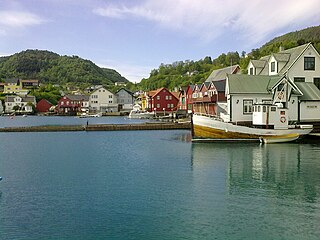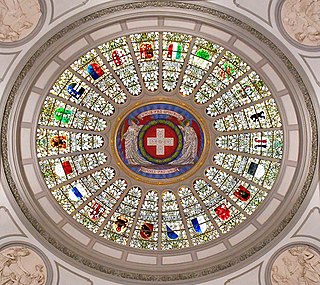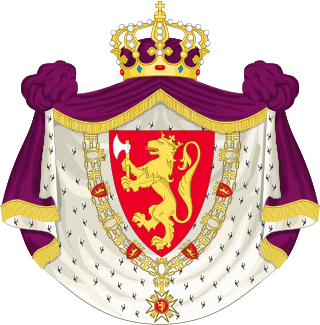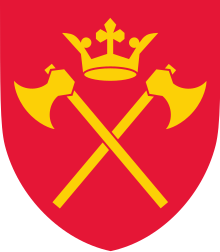Fasces is a bound bundle of wooden rods, sometimes including an axe with its blade emerging. The fasces is an Italian symbol that had its origin in the Etruscan civilization and was passed on to ancient Rome, where it symbolized a magistrate's power and jurisdiction. The axe originally associated with the symbol, the Labrys the double-bitted axe, originally from Crete, is one of the oldest symbols of Greek civilization. To the Romans, it was known as a bipennis.

Hordaland was a county in Norway, bordering Sogn og Fjordane, Buskerud, Telemark, and Rogaland counties. Hordaland was the third largest county, after Akershus and Oslo, by population. The county government was the Hordaland County Municipality, which is located in Bergen. Before 1972, the city of Bergen was its own separate county, apart from Hordaland. On 1 January 2020, the county was merged with neighbouring Sogn og Fjordane county, to form the new Vestland county.

Sveio is a municipality in Vestland county, Norway. Sveio is a border district that is sometimes considered to be located in the traditional district of Haugalandet since it is located on the Haugalandet peninsula, but it is also considered to be in the traditional district of Sunnhordland since it is located in southern Hordaland county. The administrative centre of the municipality is the village of Sveio. Other villages in the municipality include Auklandshamn, Førde, Våga, and Valevåg.

Tysnes is a municipality in Vestland county, Norway. It is located in the traditional district of Sunnhordland. The administrative centre is the village of Uggdal. Other population centres in Tysnes include the villages of Våge and Onarheim. The island municipality is located in a group of islands near the mouth of the Hardangerfjorden. The majority of the municipal population lives on the island of Tysnesøya, the largest island in the municipality.

Three Crowns is the national emblem of Sweden, present in the coat of arms of Sweden, and composed of three yellow or gilded coronets ordered two above and one below, placed on a blue background. Similar designs are found on a number of other coats of arms or flags.

The coat of arms of Ukraine is a blue shield with a gold trident. Officially referred to as the Emblem of the Royal State of Volodymyr the Great, or, colloquially, the tryzub, the insignia derives from the seal-trident of Volodymyr the Great, the first Grand Prince of Kyiv.

Each of the 26 modern cantons of Switzerland has an official flag and a coat of arms. The history of development of these designs spans the 13th to the 20th centuries.

The Royal Norwegian Order of Saint Olav is a Norwegian order of chivalry instituted by King Oscar I on 21 August 1847. It is named after King Olav II, known to posterity as St. Olav.

The coat of arms of Norway is the arms of dominion of king Harald V of Norway, and as such represents both the monarch and the kingdom. It depicts a standing golden lion on a red background, bearing a golden crown and axe with silver blade.

The Norwegian royal families are the families of either previous or present Norwegian monarchs. The current family who holds the throne are members of the House of Glücksburg and ascended the throne after the election of Prince Carl during the dissolution of the Swedish-Norwegian union in 1905.

The coat of arms of the Slovak Republic consists of a red (gules) shield, in early Gothic style, charged with a silver (argent) double cross standing on the middle peak of a dark blue mountain consisting of three peaks. Extremities of the cross are amplified, and its ends are concaved. The double cross is a symbol of its Christian faith and the hills represent three symbolic mountain ranges: Tatra, Fatra, and Matra.

The coat of arms of Montenegro was officially adopted by the law passed in the Parliament on 12 July 2004. It is now the central motif of the flag of Montenegro, as well as the coat of arms of the Army of Montenegro. It was constitutionally sanctioned by the Constitution proclaimed on 2 October 2007.

The coat of arms of Denmark has a lesser and a greater version.

The Norwegian monarch is the head of state of Norway, which is a constitutional and hereditary monarchy with a parliamentary system. The Norwegian monarchy can trace its line back to the reign of Harald Fairhair and the previous petty kingdoms which were united to form Norway; it has been in unions with both Sweden and Denmark for long periods.

Rex Perpetuus Norvegiæ (Latin), i.e. Norway's Eternal King) is a term for King Olaf II of Norway, also known as Saint Olaf.

The flag of Sardinia, called the flag of the Four Moors or simply the Four Moors, represents and symbolizes the island of Sardinia (Italy) and its people. It was also the historical flag and coat of arms of the Aragonese, then Spanish, and later Savoyard Kingdom of Sardinia. It was first officially adopted by the autonomous region in 1950 with a revision in 1999, describing it as a "white field with a red cross and a bandaged Moor's head facing away from the hoist in each quarter".

The flag of Trondheim is one of the official symbols of the city and municipality of Trondheim in Norway.

The coat of arms of Colchester is the arms and other insignia associated with the city and borough of Colchester, England.

Icelandic heraldry is the study of coats of arms and other insignia used in Iceland. It belongs to the German-Nordic heraldic tradition, as the heraldry of Iceland has been primarily influenced by the heraldic traditions of Norway, Denmark and other Nordic countries. Iceland does not have a strong sense of heraldic tradition, however, because the country lacks a governing body to oversee this. As a result, coats of arms registered as such are virtually nonexistent in modern Iceland. While many municipalities use more or less heraldic logos, there are no heraldic standards to which these must adhere, and they are registered as graphic designs rather than as coats of arms.
















